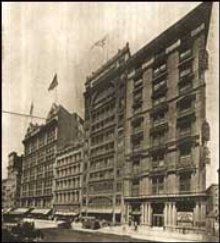|
|||||||||
|
|
|||||||||
|
|||||||||
|
|
|||||||||
|
If you compare New York City’s Soho neighborhood with the Soho of more than a century ago, it’s as though you’ve been transported to another world. Soho was once a lush green pasture with farms and fileds. The world’s largest collection of iron-clad building facades would come along later. Lush Green Meadows: Soho’s Historic Past In the 1700’s, Soho had the highest vantage point in all of Manhattan. Located near Mulberry and Grand Streets, Bayard Mount was used as a training ground in the Revolutionary War by American spy Nathan Hale. He spent six months in Soho in 1776 building fortifications for George Washington’s army to defend New York City from the British. The land at Bayard Mount was owned by the wealthy Bayard family who immigrated from the Netherlands in the 1600’s. Frequently at odds with the British authorities in New York, the family’s estate was a large plot of land with a sweeping vista of lower Manhattan. Soho’s ‘Suburban’ Transformation In the middle of the 18th century, Soho became a suburban shopping enclave for Manhattan residents who truly lived downtown near Wall Street and the Battery. The transformation was spurred by Soho’s architectural renaissance into the world’s largest collection of cast iron commerical residential buildings. Soho’s cast iron buildings were built by a vareity of pioneers in urban architechture. Cast eventually became iron the metal of choice in the late 19th century. The material’s fire-resistant properties and tensile strength made it possible to erect large building facades at less cost than comparable stone fronts. The E.V. Haughwout Building on Broadway and Broome Street was a symbol of cast iron’s innovative use. Built in roughly a year’s time, it was home to what The New York Times called “the greatest china and porcelain house in the city.” More importantly, when the Haughwout Building opened in 1857, it showcased the New York City’s first passenger safety elevator. Created by the founder of Otis Elevators, this building feature enabled store patrons to go from floor-to-floor with speed and efficiency. Soho Was Home To Manhattan’s First Red Light District According to the authors Alanna Siegfried and Helene Zucker Seeman, the influx of foot traffic and business to Soho in the 1850’s had another effect on the neighborhood’s residents and buildings: Soho became home to New York City’s first red light district. Some of the neighborhood’s reported bordellos were, in the 1850’s centrally located in Soho at 119 Mercer Street and 76 Greene Street. In a stunning juxtaposition of how far Soho has changed, the house of ill repute formerly located at 119 Mercer is now home to a high-end day spa, the Soho Sanctuary, “designed for women by women who wish to restore health, beauty and vitality within.” The former Greene Street bordello was rebuilt by J.F. Duckworth in the early 1870’s as a French Second Empire style warehouse . The Greene Street address is now occupied by……a Starbucks. Manufacturing and Light Industry: Soho In The Industrial Revolution At the beginning of the 20th century, the Soho neighborhood had changed once again, earning a reputation as a manufacturing and commercial zone during the industrial revolution. The New York City’s population was exploding from immigration, and Soho was no longer a suburb of downtown Manhattan. Retail stores had gone further north, up Fifth Avenue and Broadway. Light industry and manufacturing companies using an abundance of available immigrant labor now occupied Soho’s cast iron district. Textiles (‘schmates’, in Yiddish), fashion accessories, and a variety of cheap household necessities were manufactured in Soho’s commercial lofts. Preservationists, Artists, and Architects Say: “No” to LoMEx Soho’s lofts and the largest collection of cast-iron buildings in the world might not be around today, if it wasn’t for the protests and political fight of preservationists, architects, artists, historians, and other Soho residents. Working together in the mid-1960’s, they protested New York City’s attempts under Mayor Robert Wagner to carry out a decades-old plan for constructing a ‘Lower Manhattan Expressway’ (‘LoMEx’) as a thoroughfare for heavy traffic from the Holland Tunnel on the Hudson River to the Williamsberg Bridge on the East River. |
 New York City's Soho neighborhood is the loft capitol of the world. |